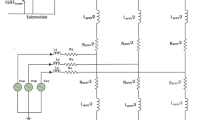Abstract
A modular multilevel converter (MMC) is one of the latest multilevel converters used for high and medium-voltage power conversion. It is based on cascade connection of multiple identical modules using IGBTs as switching devices. Module switches of MMC are preferably driven by a source derived from the module capacitor. In each MMC module, the control circuit, consisting of gate drivers, is powered from a dc supply derived from the local capacitor. The module capacitors need to be pre-charged, to power the control circuit. The problem faced while doing so experimentally for MMC with two modules per arm and a solution have been reported earlier. If a fly-back converter is used to generate the power supply for driving the control circuit, the module capacitor voltages become unstable during uncontrolled pre-charging. It has been reported earlier that the reason for this is approximately constant power load on the module capacitor. This work provides theoretical understanding of the problem and shows by analysis that the power supply can be made stable if the load on the module capacitor is made a positive resistance load. As the complexity of MMC with more than two modules per arm is higher, the phenomenon is studied by simulation for MMC with four modules per arm. It shows that when a fly-back converter is used for generating the power supply, similar instability occurs in MMC with four modules per arm. It shows that when the module capacitor is made to have a load with positive resistance characteristics, the module capacitor voltages and consequently the power supplies stabilize even for MMC with four modules per arm. It further shows that even if the load on the module capacitor is negative resistance type, when fly-back converter is used to generate the module power supply, by switching devices in those modules where power supply becomes available first, followed by sorting algorithm, stable power supplies can be developed on all the modules and the capacitors can be fully charged to the desired voltage.


















Similar content being viewed by others
References
Lesnicar A and Marquardt R 2003 An innovative modular multilevel converter topology suitable for a wide power range. In: Proceeding of the IEEE Bologna Power Tech Conference, Italy
Hagiwara M, Maeda R and Akagi H 2011 Control and analysis of the modular multilevel cascade converter based on double-star chopper-cells (MMCC-DSCC). IEEE Trans. Power Electron. 26:1649–1658
Konstantinou G S and Agelidis V G 2009 Performance evaluation of half-bridge cascaded multilevel converters operated with multicarrier sinusoidal PWM techniques. In: Proceeding of the IEEE Conference on Industrial Electronics and Applications, Xi’an
Siemaszko D, Antonopoulos A, Ilves K, Vasiladiotis M, Ngquist L and Hans-Peter Nee 2010 Evaluation of control and modulation methods for modular multilevel converters. In: Proceeding of the International Power Electronics Conference, Sapporo
Tu Q, Xu Z and Zhang J 2010 Circulating current suppressing controller in modular multilevel converter. In: Proceedings of the 36th Annual Conference of the IEEE Industrial Electronics Society, Glendale
Hagiwara M and Akagi H 2009 Control and experiment of pulse width modulated modular multilevel converters. IEEE Trans. Power Electron. 24:1737–1746
Marquardt R and Lesnicar A 2004 New concept for high voltage modular multilevel converter. In: Proceeding of the Power Electronics Specialists Conference and Exhibition, Aachen, Germany
Glinka M 2004 Prototype of multiphase modular-multilevel-converter with 2-MW power rating and 17-level-output-voltage. In: Proceeding of the Power Electronics Specialists Conference
Joshi S, Sreejith M R, Chandorkar M C and Shukla A 2014 MMC modules with control circuit powered from module capacitor voltage. In: Proceedings of the IEEE PEDES Conference Mumbai, India
Sreejith M R 2014 Electrical source emulation using modular multilevel converter. M.Tech. Thesis. Mumbai, India: Deptartment of Electrical Engineering, IIT Bombay
Li B, Xu D, Zhang Y, Yang R and Wang G 2015 Closed-loop pre-charge Control of modular multilevel converters during start-up processes. IEEE Trans. Power Electron. 30:(2) 524–531
Shi K, Shen F, Lv D, Lin P, Chen M and Xu D 2012 A novel start-up scheme for modular multilevel converter. In: Proceedings of the IEEE Energy Conversion Congress and Exposition
Acknowledgements
The authors would like to thank the NaMPET (National Mission on Power Electronics Technology launched by the Department of Electronics and Information Technology under Ministry of Communications and Information Technology, Government of India), which supports the present work.
Author information
Authors and Affiliations
Corresponding author
Appendix
Appendix
Referring to Eq. (6) , all the co-efficients in the numerator and the denominator of the transfer function are positive. The denominator is a third-order equation. Consider a third-order polynomial given by the equation
Applying Routh’s Stability Criterion to confirm that the system is stable, the conditions for all roots to have negative real part are given by
Comparing Eq. (11) with the denominator of Eq. (6) results in the following:
To evaluate the parameters in these equations, values of \( R_{1} \) and \(R_{2}\), which represent incremental load resistances as seen by the module capacitors, have to be found out. Referring to figure 10, the module capacitor, voltage \( V_{c} \) is reduced to a voltage \( V_{i} \) by the forward converter operating at a fixed duty cycle by a factor of 5. The input resistance offered by the forward converter is the effective load resistance seen by the module capacitor. If the incremental quantities are indicated by small letters, the load resistance \( R_{1} \) is given by the relation
Assuming the losses in the forward converter to be negligible, the current \( i_{c} \) and the voltage \( v_{c} \) are given by
The linear regulator is a series pass regulator and its output current \( i_{0} \) is the same as the input current \( i_{i} \). The output voltage \( V_{0} \) is about 15 V and average current drawn from the output is 0.15 A. Hence the effective resistance at the output of the linear regulator is 100 \(\Omega \). If \( v_{0} \) is the incremental voltage change in the output voltage \( V_{0} \) and \( v_{i} \) is the input, the regulator, from the data for input voltage regulation for TL783 of
From Eq. (17)–(21) the resistance \( R_{1} \) is given
Hence the incremental load resistance \( R_{1} \) for the module capacitor, as shown by (22), is 4.17 M\( \Omega \). With identical MMC modules the value of the second module load resistance \( R_{2} \) is assumed to be the same.
With these values of \( R_{1} \) and \( R_{2} \), L equal to 3 mH and C equal to 1 mF, Eqs. (13)–(16) are evaluated. The necessary and sufficient condition for the system is given by (12). Eq. (12) is satisfied as \( a_{1}a_{2} = 3600\times 10^{9} \) and \( a_{0}a_{3} = 431\times 10^{9} \) . Hence it is proved that the system is stable.
Rights and permissions
About this article
Cite this article
Joshi, S.D., Chandorkar, M.C. & Shukla, A. Pre-charging of module capacitors of MMC when the module switches are driven by a source derived from the module capacitor. Sādhanā 42, 1251–1262 (2017). https://doi.org/10.1007/s12046-017-0655-3
Received:
Revised:
Accepted:
Published:
Issue Date:
DOI: https://doi.org/10.1007/s12046-017-0655-3




